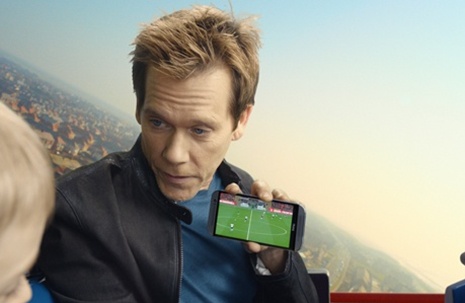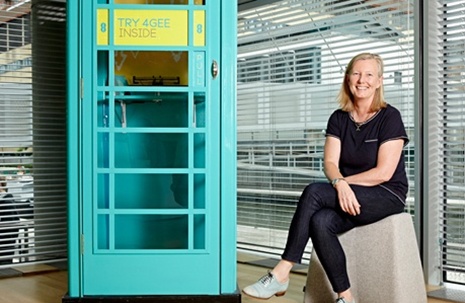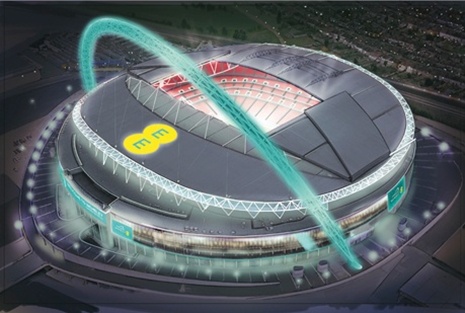Profile: Pippa Dunn, chief marketing officer EE
In her first interview since taking responsibility for the EE brand, CMO Pippa Dunn tells how she plans to win consumers’ mobile-fickle hearts, improve its ’most complained about’ customer service and build on the awareness of its huge Kevin Bacon campaign.
“I’m very keen that we innovate – not only in terms of our products and propositions but also in our marketing,” says Pippa Dunn, chief marketing officer of EE, in her first major interview since taking over from brand chief Steven Day at the end of last year. “We launched as a fresh, innovative brand when the rest of the telco industry had become a bit staid and we’re very much known for that innovation.”
One certainly cannot accuse EE of playing it safe. As the country’s largest mobile network with 26 million customers, EE has redrawn the mobile map since it was formed from the merger of Orange and T-Mobile’s UK businesses in 2010.
The brand was the first to launch 4G mobile internet two years later and has become one of the country’s biggest and brashest advertisers, synonymous with its bright-yellow branding and TV spots fronted by Hollywood actor Kevin Bacon[1] (no relation to this article’s author).
Following a sustained marketing blitz aimed at establishing the brand and building awareness, EE now faces the challenge of winning a place in consumers’ hearts. That is no easy task in an industry where customers are notoriously fickle, swayed more by tariffs than brand values, and where perceptions of customer service have hit rock bottom.
We need to consistently invest in the brand to keep it top of mind for consumers
Dunn is charged with taking the EE brand forward following Day’s departure last December[2]. His resignation to pursue “new adventures” meant that management of the EE brand team shifted to Dunn, who also has responsibility for all consumer-facing propositions and product development. While Dunn’s job title has not changed, her new responsibilities bring brand communications and market strategy within a single role.
“It means everything is joined up, from brand awareness through to in-store execution, proposition development, pricing, the devices that we sell and so on,” she explains.
The management restructure coincides with attempts by EE to extend its appeal beyond early technology adopters and encourage the mass market to move to 4G. Only 3.6 million of the company’s customer base are on EE contracts that run 4G, with the remaining 22 million still on Orange or T-Mobile deals that run 3G or less.
O2, Vodafone[3] and Three all launched 4G networks towards the end of last year although their 4G coverage lags significantly behind that of EE. According to research firm Enders Analysis, EE has a 33 per cent share of the total UK mobile market versus 26 per cent each for O2 and Vodafone.
Dunn’s marketing projects this year have focused on helping the brand compete with these rivals and draw in new customers. In January, EE launched its ‘No Brainer’ brand platform to highlight its deals and offers on different contracts, while the following month it became the first lead sponsor of Wembley Stadium in a six-year deal. The sponsorship is both a brand awareness tool and “a showcase for our innovation”, Dunn says (see box, below)[4].
But despite these new activities, EE is sticking to its tried-and-tested advertising formula. Dunn confirms that Kevin Bacon will remain at the heart of the brand’s advertising for the foreseeable future and that TV will continue to be a central channel despite EE’s increasing investment in digital marketing.
“We are doing well on awareness but we’re still a new brand so we need to invest,” says Dunn. “Because we don’t have the ad stock of brands that have been around longer, we need to consistently invest in the brand to keep it top of mind.”
Kevin Bacon campaign

EE plans to continue using actor Kevin Bacon in its advertising
The Kevin Bacon ad series began in October 2012 to coincide with the launch of 4G. The fast-talking actor conveys the theme of connectivity by playing on the cult ‘Six degrees of Kevin Bacon’ game, which suggests that any actor is just six connections away from the Hollywood star.
The spots have performed consistently well in surveys of the most recalled ads, suggesting they have done well at driving brand awareness. But the campaign is not without detractors, who complain the ads are annoying, confusing or both.
Dunn is quick to defend the Saatchi & Saatchi-created ads, claiming that the brand’s own research shows the Kevin Bacon spots are resonating with consumers and helping to differentiate EE from competitors. In addition, she says they have helped to establish an “irreverent, quirky and approachable” tone for the brand that shows it does not take itself too seriously.
“In a telco world that has been dominated by metaphors, we took the decision to actually use a person as a spokesman who can talk about the services we offer, rather than doing it in a more ethereal way,” she says.
“The responses that we see to our advertising compared with our competitors’ show we’re seen as differentiated, unique and innovative. The core message that we’re trying to get across around being the biggest and fastest network is coming through very clearly from our market research.”
EE’s current advertising continues to hammer home this core message about network strength. The latest TV ad refers to findings from mobile analytics firm RootMetrics showing that EE is the UK’s number one operator for both speed and reliability. Dunn points out that the brand’s advertising is also shifting to focus more specifically on the types of activities enabled by high-speed 4G and data-heavy contracts, such as streaming live TV or sharing content with friends.
I believe you always need a really solid product before you can market it. Consumers aren’t gullible so unless you’ve got that true foundation, you’ll get caught out at some point
At over 70 per cent, EE’s 4G coverage is the widest of any UK network and it continues to expand to more towns, villages and transport routes such as roads, railways and airports. Dunn says network strength is the brand’s primary advantage over its competitors and an area it must continue to work on, such as by improving call quality and reducing dropped calls.
“I believe you always need a really solid product before you can market it,” she says. “Consumers aren’t gullible so unless you’ve got that true foundation, you’ll get caught out at some point.”
However, consumer backlash is particularly common in the mobile sector, which is frequently rated among the worst industries for customer service. EE itself has struggled with customer service issues and was last month named by Ofcom as the most complained-about mobile operator and broadband provider in the first quarter of 2014.
Dunn acknowledges there is significant room for improvement by the brand but points also to the acute service challenges facing mobile operators. Earlier this year, EE announced plans to return over 1,000 customer service roles to the UK from overseas call centres. The company is also investing in its own analytics to determine the reasons behind customer service calls and to develop “a digital self-help platform” that will enable customers to find solutions to their problems more easily.
“We’re working with something now that isn’t just a phone – it’s a computer,” says Dunn. “All of the issues that customers historically had with a PC – which had a totally different service model from the one associated with a mobile phone – are coming back to the telco operators now.
“Quite often it may be a handset fault rather than a network fault, but because we sold the customer the phone, consumers come to us and therefore we need to fix whatever issues they have. It’s a big and complicated area and one that is increasing the demand on resources.”
Juggling three brands

EE’s customer service issues are made more complex by the fact that it continues to operate with three separate brands. Although EE-branded stores have steadily replaced Orange and T-Mobile shops on UK high streets, Dunn says there are no plans to phase out the other brands completely.
The switch-on of the EE network in late 2012 provided both good and bad PR for the company as large groups of Orange and T-Mobile customers complained of feeling confused about the new brand and what it meant. This was compounded by EE’s own rebrand at the time, having previously used the name Everything Everywhere.
However, Dunn says any early teething problems were not the result of a marketing failure but rather an inevitable consequence of introducing a new brand to over 20 million customers. She believes this transition phase was relatively brief and that the continued existence of the three brands under the same company provides EE with different options in the marketplace, particularly as it looks to move people to 4G contracts.
“We have one overarching brand, which is EE – the network is EE, the stores are EE, the websites are EE – but we have three trading propositions that we take to market: Orange, T-Mobile and EE,” notes Dunn.
“That gives us maximum flexibility around the tariffs and propositions that we offer customers.”
Dunn herself has an acute understanding of the dynamic between the three brands, having worked for Orange for eight years before assuming an EE-specific role in 2011 (see CV)[5]. EE is now structured around business segments, rather than separate brand teams, meaning that in her current role Dunn has responsibility for all three brands across different business lines such as pay monthly and pay-as-you-go.
Dunn trained as a lawyer but decided against a law career and, upon completing her training, went to work for a theatre production company. Her first break in marketing came four years later when she was encouraged to apply for a job as a sponsorship manager at Coca-Cola by a friend who worked at the soft drinks group.
“I said I didn’t have any experience but he said ‘Don’t worry about that – Coke’s a great place to learn and train, so if you’ve got the enthusiasm and aptitude, we can do the rest,’” she explains.
Dunn’s first role involved working on Coca-Cola’s sponsorship of the Euro ’96 football tournament in England and she also worked in brand management during a five-year stint with the company. She remains an advocate of developing marketing talent within organisations and heads a marketing graduate programme for EE that takes on eight to 10 graduates a year.
“I spend quite a lot of time bringing new talent into the business,” she says. “We’re now in the top 25 big businesses to work for, according to The Sunday Times, with some of the most talented people you could hope to work with.”
Dunn’s job is to harness that talent to ensure EE continues to thrive in a highly competitive industry. The mobile sector is a commoditised market in which brands must continually add new customers to compensate for those who switch to new deals elsewhere. Dunn describes her biggest challenge as “growing top-line revenue” while managing a large base of existing customers.
This is where her attachment to innovation comes in. EE is developing technology across a huge range of areas, from contactless payments to the connected car to a recent announcement about Wi-Fi enabled phone calls. In May, the company also became a founding member of the Mobile Video Alliance to facilitate better viewing experiences on smartphones. All these activities are designed to create new business lines and give EE the edge over rivals.
The Wembley sponsorship, meanwhile, will both support product innovations around the concept of a ‘connected stadium’ as well as provide EE with an important tool in the loyalty and rewards market. Although the company’s loyalty offer lags behind that of some of its rivals, Dunn reveals that EE is “looking end-to-end at what we do in terms of loyalty across all product propositions”. In the wake of O2’s recent push for its Priority platform, EE must respond and Dunn says the brand will take action in the loyalty market “in due course”.
All this means that Dunn has plenty to keep her occupied, although she shows no signs of fatigue. Much like brand ambassador Kevin Bacon, it seems that energy and enthusiasm are the order of the day at EE.
“There is a really strong sense of passion within the business, with people working very hard towards our common goals,” says Dunn. “I find that very rewarding.”
CV - Pippa Dunn
2011-present
Chief marketing officer – consumer, EE
2010-11
Vice-president of Orange propositions
2007-10
Pay-as-you-go director, Orange
2004-07
UK brand director, Orange
2003-04
Global sponsorship director, Orange
2001-03
Product marketing director, NTL
1999-2000
Head of sponsorship, Coca-Cola
1997-99
Brand manager, Coca-Cola
1995-97
Sponsorship manager, Coca-Cola
1993-95
General manager, Apollo Leisure Group
Loyalty and new tech

EE’s agreement with Wembley allows the operator to compete directly with O2’s Priority initiative
EE’s six-year sponsorship deal with Wembley Stadium is a significant development in the mobile loyalty battle. By becoming Wembley’s first lead brand partner, EE can offer its members exclusive access to sports events and concerts at the venue, enabling it to compete directly with O2’s Priority initiative, which gives early access to tickets at The O2 arena and other venues.
EE currently lacks a comparable loyalty platform to O2 Priority, although the Orange Wednesdays cinema offer continues to run, under the strapline ‘Brought to you by EE’. Dunn says the company is looking at customer incentives across its different business lines, with an EE loyalty strategy expected “in due course”.
EE aims for Wembley to serve as an innovations hub. This includes an ambition to make it “the most connected stadium in the world” by rolling out mobile ticketing solutions and super-fast Wi-Fi for all visitors. Dunn also believes the sponsorship will serve as an important means of winning customers in the valuable business-to-business market. “This is a great tool to be able to bring B2B customers into an EE environment and show them what we can do,” she says.
Last month EE used its sponsorship of the Glastonbury Festival to unveil further innovations, including small devices called Power Bars that enable festival-goers to charge up their phone batteries and trade them in for fresh ones each time they run out. It meant that visitors could charge up their phones without having to queue up at the EE recharge tent.
EE also worked with Glastonbury to create an official festival app with tools for helping users schedule their choice of performances and an interactive festival map.
My biggest challenges
Growing the top line
“Top-line revenue growth is challenging in a market that has lots of regulatory headwinds. Part of my role is to manage not only our large customer base but also to think of new lines of business and how we can package them and communicate them effectively.”
Maximising sponsorships
“You need to have very clear objectives for what you’re trying to do with a sponsorship. For us, Wembley is quite simple: it’s part of our awareness drive but it’s also an opportunity to demonstrate that we have the capability to make the world’s most connected stadium.”
Improving customer service
“There is a quote that ‘The best source of insight is from your most dissatisfied customers’. We’re spending a lot of time looking at why people call and the root causes of their issues, and then investing money, time and effort in our people and processes to put them right.”
References
- ^ Kevin Bacon (www.marketingweek.co.uk)
- ^ Day’s departure last December (www.marketingweek.co.uk)
- ^ Vodafone (www.marketingweek.co.uk)
- ^ (see box, below) (www.marketingweek.co.uk)
- ^ (see CV) (www.marketingweek.co.uk)









